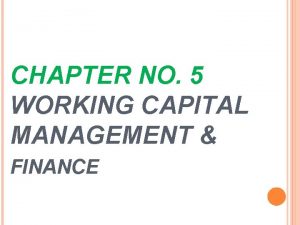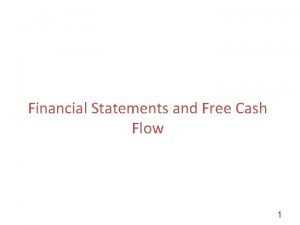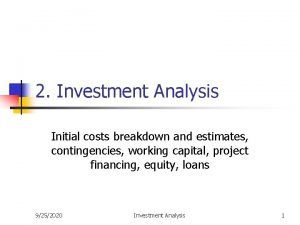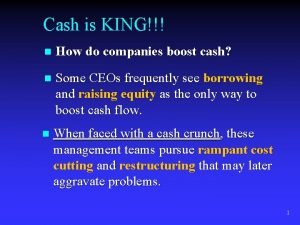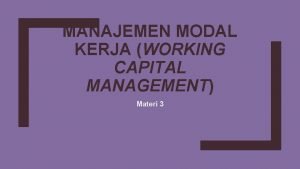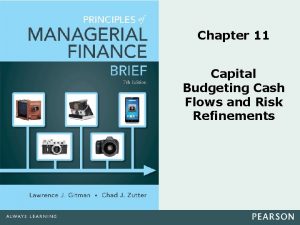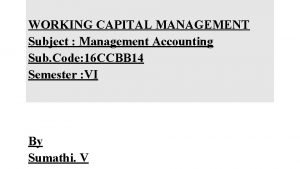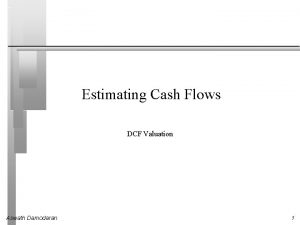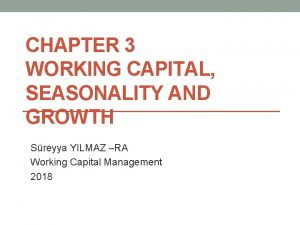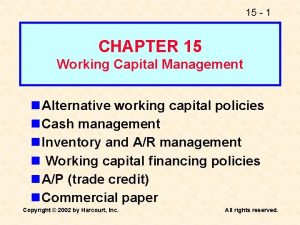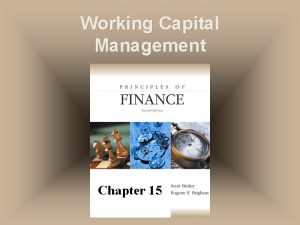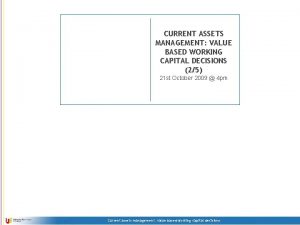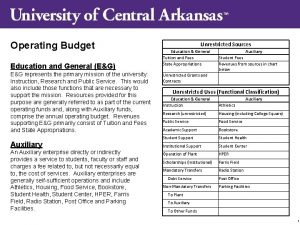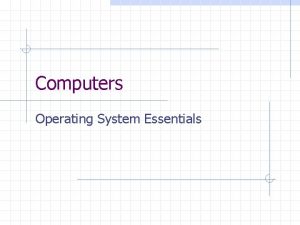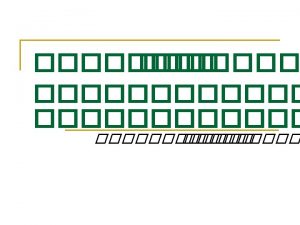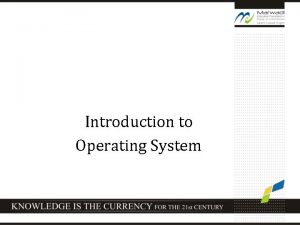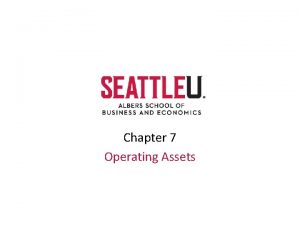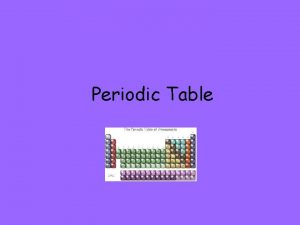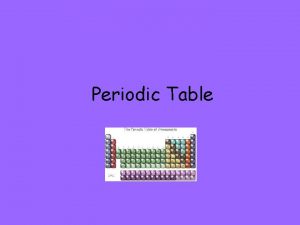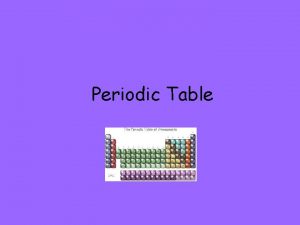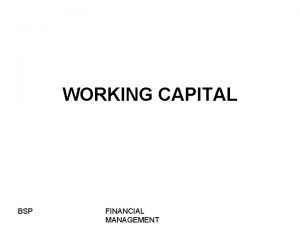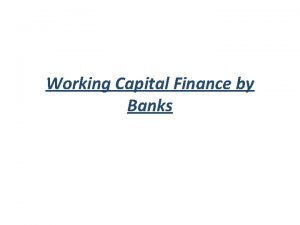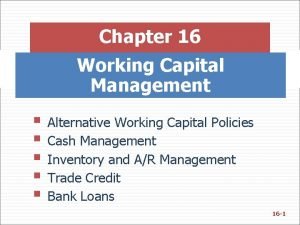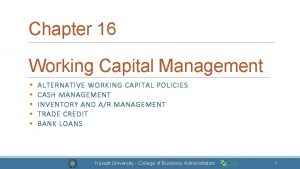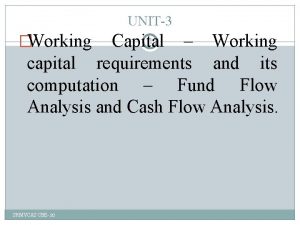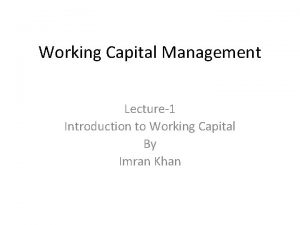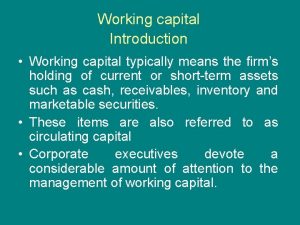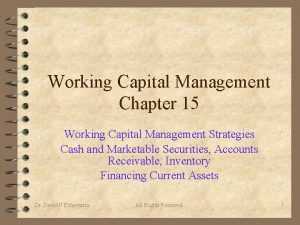WORKING CAPITAL WORKING CAPITAL Working Capital represents operating


























- Slides: 26

WORKING CAPITAL

WORKING CAPITAL • Working Capital represents operating liquidity available to a business. • This is short term capital or finance that a business keeps. • Working capital is the money used to meet day to day working in business concern such as salary, rent, energy bills, purchases etc.

Working Capital • Working capital is defined as • Working Capital = Current Assets – Current Liabilities.

Balance Sheet of Company X Liabilities Assets Current Liabilities Rs. 3200 Current Assets Rs. 5400 Long Term Debt Rs. 4800 Fixed Assets Rs. 8600 Equity Capital Rs. 6000 Rs. 14000

Current Assets • Current assets are short term source of finance such as • Stocks / Inventories • Debtors • Cash Equivalent – these are short term and highly liquid investments which are easily and immediately convertible in to cash.

Current Liabilities • Current liabilities are short term requirements for cash. • trade creditors • Bills payable • Bank credit • Taxes • dividend

Working capital management • Task of the finance manager in managing working capital efficiently is to ensure sufficient liquidity in the operations of the business. • The liquidity of the firm is measured by its ability to satisfy short term obligations as they become due.

Measures of liquidity • The three basic measure of a firm’s overall liquidity are • 1) Current Ratio • 2) Acid Test Ratio • 3) Net Working Capital

Current Ratio • The current ratio is the ratio of total current assets to total current liabilities. Current Assets • Current Ratio = -------------Current Liabilities

CURRENT RATIO • Its measurement of short term solvency. • It indicates the rupee of current assets available for each rupee of current liability. • Conventionally a current ratio of 2 : 1 is considered satisfactory. •

Current ratio • Current Assets ------------ = Current Liabilities = Firm A Firm B 1, 80, 000 -------1, 20, 0000 30, 000 ------10, 000 3: 2 3: 1

Current Ratio • In case of company A, the current ratio is 3 : 2. • It implies that for every two rupees of current liabilities, three rupees of current assets are available to meet them. • In case of company B, the current ratio is 3: 1. • It implies that for every rupees of current liabilities, three rupees of current assets are available to meet them.

Current ratio • The liquidity position, as measured by current ratio, is better in company B as compared to company A. • In inter firm comparison, the firm with higher current ratio has better liquidity / short term solvency.

Acid Test Ratio • The acid test ratio is the ratio of quick current assets to total current liabilities. Quick Assets • Current Ratio = -------------Current Liabilities

Acid test ratio • Quick asset refers to current assets which can be converted into cash immediately or at a short notice without diminution of value. • It is a rigorous measure of a firm’s ability to serve short term liabilities. • An acid test ratio of 1: 1 is considered satisfactory.

Net Working Capital • Net working capital represents the excess of current assets over current liabilities. • Although NWC is really not a ratio, it is frequently employed as measure of a company’s liquidity position. • An enterprise should have sufficient working capital in order to be able to meet the claims of the creditors as well as daily needs of the business.

Need for working capital • Need for working capital arises because sales do not convert into cash immediately. • There is invariably a time lag between the sale of goods and the receipt of cash. • Therefore, sufficient working capital is necessary to sustain sales activity. • Technically, this is refereed to as operating cycle.

Operating Cycle • The operating cycle consists of three phases. • Phase 1 - cash get converted into inventory • Phase 2 – the inventory is converted into receivables as credit sales are made to customers. • Phase 3 – Receivables are collected.

Permanent & Temporary Working Capital • To carry on business, a certain minimum level of working capital is necessary on a continuous basis. • This requirement will have to be met permanently. • Any amount above the permanent level of working capital is temporary, fluctuating or variable working capital. • Temporary working capital requirement arises due to seasonal fluctuation of business activity.

Permanent & Temporary Working Capital Figure shows that permanent level is fairly constant, while temporary working capital is fluctuating in accordance with seasonal demand. Temporary Permanent Time

Permanent & Temporary Working Capital • In case of expanding firm, the permanent working capital line may be horizontal. Temporary Permanent Time

Financing of W. C. • The source of finance for working capital are mainly as under. • 1) Trade Credit • 2) Bank Credit • 3) Current provisions and non bank short term borrowings • 4) Long term source comprising equity capital and long term borrowings.

Financing of W. C. • In India the primary source for financing working capital are trade credit and short term bank credit.

Bank Credit • The bank credit is the primary institutional source of working capital finance. • To obtain short term bank credit, working capital requirement is estimated by borrowers and then banks are approached with necessary supporting data. • The bank determine the maximum credit based on the margin requirement of the security.

Bank Credit • The margin represents a percentage of the value of the asset offered as security by the borrower. • For ex, if the margin requirement on a particular item is 50%, the bank will provide credit upto Rs. 50, 000 against the security of an asset worth Rs. 1, 000.

Forms of Credit • After getting the overall credit limit sanctioned by the banker, the borrower draws fund periodically. The following forms of credit area available to him: • 1) Loan Arrangement • 2) Overdraft Arrangement • 3) Cash Credit Arrangement • 4) Term Loan for working capital
 Operating cycle method
Operating cycle method Operating net working capital formula
Operating net working capital formula Net operating working capital formula
Net operating working capital formula What is gross working capital
What is gross working capital Total net operating capital
Total net operating capital Modal kerja adalah
Modal kerja adalah Hot working and cold working difference
Hot working and cold working difference Differentiate between hot working and cold working
Differentiate between hot working and cold working Smart vs hard working
Smart vs hard working Proses hot working
Proses hot working Advantage of hot working process
Advantage of hot working process Working capital breakdown
Working capital breakdown Equivalent annual cost method
Equivalent annual cost method Boost working capital
Boost working capital Working capital management
Working capital management Working capital managemetn
Working capital managemetn Capital budgeting
Capital budgeting Accounting sub code
Accounting sub code Fcfe damodaran
Fcfe damodaran Ideal working capital turnover ratio
Ideal working capital turnover ratio Working capital life cycle
Working capital life cycle Negative working capital
Negative working capital Working capital financing policy
Working capital financing policy Trade working capital
Trade working capital Working capital terminology
Working capital terminology Incremental cash flow
Incremental cash flow Working capital decisions
Working capital decisions
